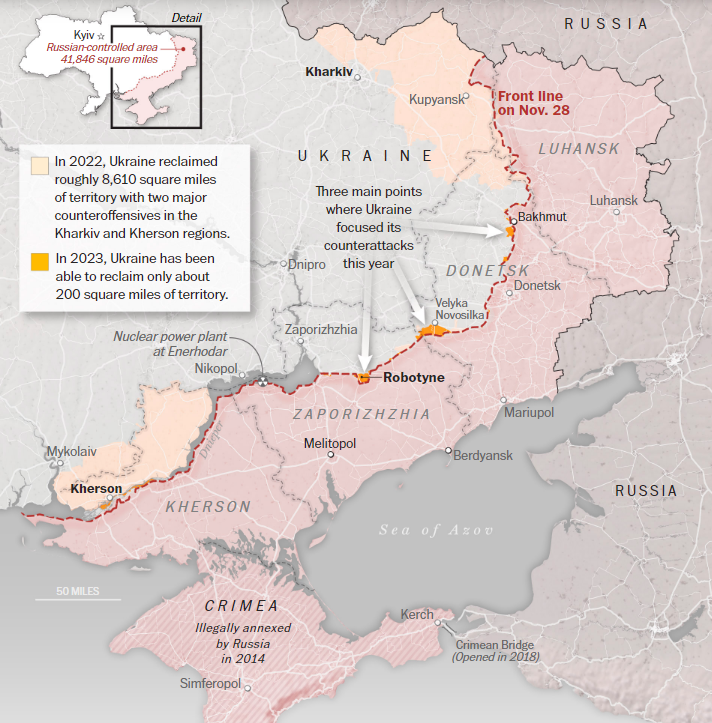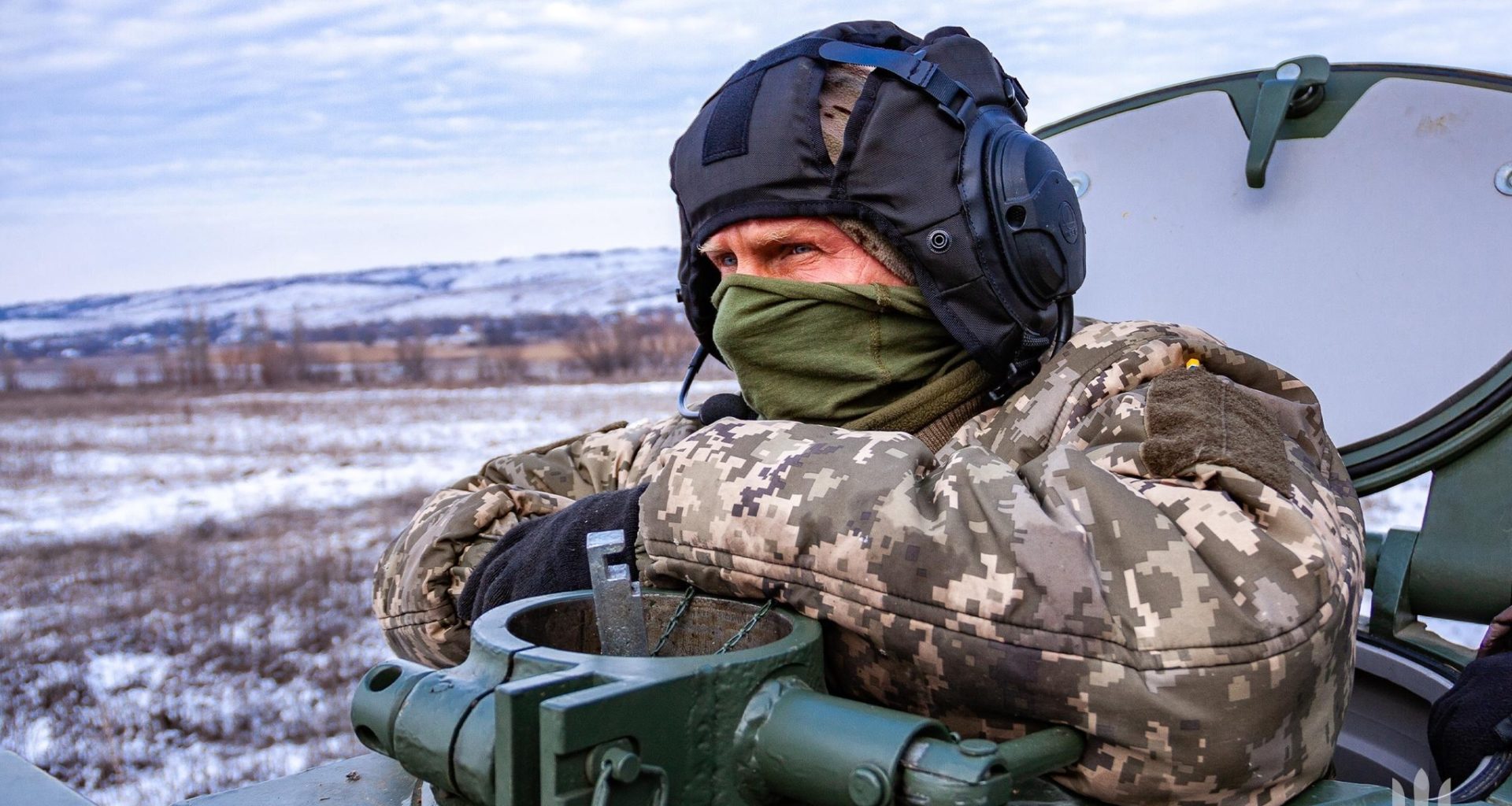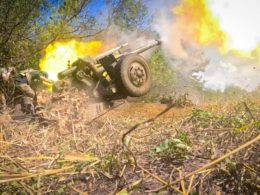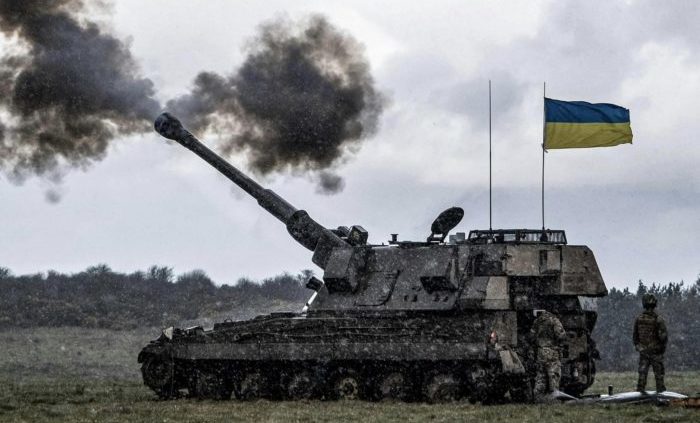The Washington Post has published a two-part story on Ukraine's counteroffensive (here and here), based on interviews with more than 30 Ukrainian and American officials, as well as more than two dozen officers and soldiers on the front lines. Here are their key findings:
20 kilometers in 100 days instead of planned Azov Sea: how we got here
- The United States military was deeply and comprehensively involved in planning and simulating the Ukrainian counteroffensive campaign, holding an extensive series of eight major multi-day tabletop war games with senior Ukrainian officers to help develop a viable and detailed battle plan. However, despite the close cooperation, there were significant disagreements and tensions between the US and Ukraine over the ideal strategy, tactics, optimal force structure, and precise timing to launch the counterattack operation.
- The Pentagon consistently and repeatedly pushed for the large-scale Ukrainian counteroffensive to commence in mid-April to prevent Russia from having substantial additional time to extensively fortify defensive positions, dig expansive trenches along the entire front line, and strengthen troop numbers in occupied territories. Ukraine continually hesitated on this ambitious timeline, insisting its forces were not yet adequately prepared, trained, or equipped to successfully launch such a massive attack without first receiving more weapons deliveries from the West and completing additional critical combat training cycles for newly formed brigades. The counteroffensive ultimately did not begin until early June.
- US military leaders were highly confident that a wide-ranging, heavily mechanized frontal assault concentrated along one sole southern axis heading directly towards the coastline could achieve a decisive breakthrough if properly supported. They advised Ukraine could penetrate Russia's multilayered defenses by marshaling a combined arms ground attack. Ukraine ultimately decided to split its forces and attack along three distinct axes which stretched their personnel, believing it would compel Russia to also stretch its troops along an extended front line.
- Ukraine quickly completely abandoned large-scale mechanized assaults relying extensively on Western-provided armored vehicles after suffering unexpectedly heavy losses of US-provided Bradleys and German-built Leopard tanks in the initial days around contested villages like Robotyne. The surprising losses contributed to Ukraine pivoting to slowly rely primarily on dismounted infantry attacks on foot with light arms rather than risk additional vehicles.
- The extensive simulation exercises concluded that in an ideal scenario if the assault went precisely according to plan, Ukraine's concentrated forces could feasibly reach the Sea of Azov in 60-90 days, cutting off Russian troop access and supply lines along the vital land bridge connecting Russia to Crimea. However, after over 100 days now at war's end, Ukraine has managed to advance only about 19 kilometers in total, with the Sea of Azov still frustratingly out of reach while Russia controls the area.
- Ukraine's top military commander has now grimly acknowledged the war has essentially reached a "bloody stalemate," starkly diverging from the bold, optimistic predictions of decisive victory against Russia's occupation forces made by hopeful Ukrainian officials early in the year as they planned their counteroffensive.
Main reasons the Ukrainian counteroffensive did not achieve expected outcomes
- Ukraine and the US underestimated the extensive Russian fortifications and defenses, which composed over 70% minefields across the 600-mile front, making effective armored maneuver warfare extremely difficult.
- The lack of air power prevented Ukraine's forces from suppressing Russian defenses, as aging Ukrainian MiG fighter jets were vastly outranged by superior Russian Su jets and the US did not provide requested F-16s.
- Newly formed Ukrainian brigades lacked adequate combat manpower and experience, with 70% of key mechanized units having zero experience prior to the counteroffensive, while Russia sacrificed higher troop losses to stall advances.
- The US and Ukraine had divided strategies, as the US pushed for a concentrated armored assault on the Southern Zaporizhzhia axis while Ukraine decided to disperse forces across three fronts to overextend the Russians.
- There was an overestimation of how rapidly Ukraine could adopt Western-style combined arms warfare, given expectations that months of NATO training could transform Soviet-style military tactics.
- Russia demonstrated the ability to quickly move reserves and reinforce positions in response to Ukrainian movements and assaults.
- Ukraine lacked sufficient long-range missile capability to effectively hit Russian command infrastructure and logistics networks behind the front lines.
- The multi-month delay in launching the counteroffensive provided Russia ample time to extensively reinforce fortified positions in key areas.
Why the Americans think the counteroffensive failed; their accusations towards Ukraine
From the American perspective, Ukraine failed to execute the counteroffensive properly and did not heed advice that could have led to greater success. The US military officials anticipated heavy losses in the campaign but thought more Ukrainian troops would ultimately be killed if Kyiv failed to mount a decisive assault, since the conflict would drag on.
The US military officials are highly critical of Ukraine spreading its forces across three attack axes instead of massing them along the southern thrust they viewed as most strategic. They believe Zaluzhnyi should have dedicated far more soldiers and equipment specifically to severing Russia's land bridge to Crimea.
Americans also accuse Ukraine of failing at basic military tactics, including not leveraging ground reconnaissance to sufficiently chart Russian minefields before advancing. The dense mine barriers ended up blunting the mechanized assaults that US officials thought could penetrate Russia's defenses. They think with proper reconnaissance and use of smoke cover to mask movements, the losses of vehicles and life could have been reduced.
In addition, the Pentagon places blame on Ukraine continuing to commit resources around Bakhmut when those brigades and weapons were needed to reinforce the south. The US commanders grew increasingly frustrated by Ukraine's refusal to shift approach despite repeatedly warning them that scattershot efforts along the entire front would fail to produce operational breakthroughs.
Overall, American military leaders seem incredulous that months of detailed planning and provision of advanced NATO weaponry did not translate into the decisive counteroffensive they envisioned if their advice was followed.
How the Ukrainians see it - their accusations and frustrations
Ukrainian military officials dispute US assertions and argue it is America that failed to understand modern battlefield dynamics. They say Western-style maneuver warfare relying on armored vehicles is obsolete against Russia's layered defenses and waves of kamikaze drones (read more in why Ukrainians think the Americans don't understand the new phase of war in our interview: Ex-Minister Zagorodnyuk: Ukraine can defeat Russia, but West must commit to total victory).
Ukraine accuses Western nations of failing to provide air power while asking them to sacrifice troops in frontal attacks. "You want us to proceed with the counteroffensive, you want us to show the brilliant advances on the front line," said Deputy Prime Minister Olha Stefanishyna. "But we do not have the fighter jets, meaning that you want us to throw our soldiers, you know, and accept the very fact that we cannot protect them."
The Ukrainians had planned to breach Russian lines with a shock armored attack supported by artillery. But on just the fourth day, Gen. Zaluzhnyi ordered his forces to halt frontal assaults before more of Ukraine's irreplaceable Western vehicles were incinerated. With the mechanized thrusts shredded by mines and anti-tank missiles, Zaluzhnyi tossed aside months of joint US-Ukrainian planning in favor of a slow, infantry-based advance.
Ukraine accuses the West of not providing enough demining vehicles, fighter jets, or attack helicopters critical for the combined arms thrusts modeled in war games. They blame late, incomplete, or faulty deliveries of Western vehicles like the Bradley for the heavy early losses that forced them to pause mechanized offensives.
Kyiv also defends concentrating forces around Bakhmut as flanks had to be protected for the counterattack. Spreading the front line was partly strategic - overstretching Russia's larger army to dilute its strength. Ukrainian generals thought Western officials ignored how the conflict had evolved with technologies like small drones.
Ultimately Ukraine's commanders felt they had no choice but to adopt slower, more conservative tactics to avoid uncontrolled losses among their depleted brigades. They saw the Americans as unrealistic about what Western systems could accomplish against an adversary willing to sacrifice unlimited lives. The Ukrainians argue they avoided disastrous defeat, while the West underestimated Russia's resilience.

Overview of counteroffensive by month
January - April 2023
- US runs 8 military simulations with Ukraine to shape counteroffensive battle plans, advocating a concentrated armored assault on the Southern axis
- Ukraine decides on a dispersed 3-front attack to stretch and distract Russian forces in the East and at multiple points in the South
- Questions arise on readiness and supply levels for assembling the necessary Ukrainian forces
- Russia rapidly enhances defensive fortifications, trench networks during the 4+ month delay before Ukraine launches the counteroffensive
May 2023
- US applies pressure on Ukraine to commence the counteroffensive due to mounting concerns over Russia continuing to reinforce positions
- Ukraine responds that numerous promised weapons and equipmentdeliveries were delayed or arrived unfit for combat
- Poor weather conditions in early Spring also delayed optimal timing for a counterattack
- Russia takes advantage of the stalled timeline to further bolster defenses
June 2023
- Counteroffensive commences but Ukrainian forces suffer heavy losses attempting armored thrusts
- Extensive minefields and pre-planned kill zones devastate mechanized assaults
- Ukraine loses 20+ Bradleys, 6 German Leopard tanks within days along with hundreds killed and wounded
- After 4 days and failed plan to take village of Robotyne, Ukraine switches tactics from armor to dismounted infantry
- Advance stalls almost immediately as operations grind to crawl facing reinforced Russian lines
July - October 2023
- Incremental gains measured in kilometers as Ukraine undertakes trench warfare offensive
- Villages like Klishchiivka in the East taken after months of bloody house-to-house fighting
- In the South, strategic areas near Berdiansk and Melitopol remain well out of reach
- US officials grow frustrated with lack of progress as rifts emerge over tactics
- Russia moves reserves rapidly to plug gaps whenever Ukraine seizes small areas of territory
- By October, offensive gains stand at recapturing approximately 300 square kilometers.
Related:
- Ex-Minister Zagorodnyuk: Ukraine can defeat Russia, but West must commit to total victory
- Ukraine’s 2023 counteroffensive and the strategic zugzwang of Western expectations





